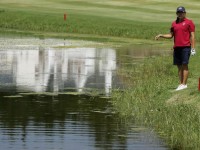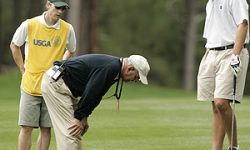Club Golf Academy takes a deeper look into two more important aspects of the the rulebook. The USGA Rules of the Week are Rule 26-1 and Rule 27-1, concerning relief from hazards and how to proceed when you hit your ball out of bounds or lose your ball.
Rule 26-1
If a ball is found in a water hazard or if it is known or virtually certain that a ball that has not been found is in the water hazard, the player has several options. The player may choose to play the ball as it lies but may not ground his club (set the club on the ground) in the hazard. If the player elects not to play the ball from the hazard, he/she must then determine which type of hazard they are in to know the relief options. If the hazard is marked by yellow stakes, we refer to that area as a water hazard. If the hazard is marked by red stakes, we refer to that area as a lateral water hazard. If the hazard is marked by stakes of both colors, determine where your ball entered the hazard and proceed with the relief options offered for whichever color stake marks the hazard where your ball entered. Determining which type of hazard your ball went into determines the amount of relief options that you have.
If a player hits his ball into a water hazard (marked with yellow stakes) and does not find his ball, or finds it and chooses not to play it, there are two relief options:
-
Proceed under Rule 27-1 (explained later in this article) and drop a ball where he/she last played from, with a penalty of one stroke.
-
Drop a ball behind the water hazard, keeping the point at which the original ball last crossed the margin of the hazard in line with the hole. The player may proceed as far back as they wish and drop the ball from shoulder height, playing it as it lies after the drop.
If a player hits their ball into a lateral water hazard (marked with red stakes) and does not find the ball, or finds it and chooses not to play it, there are four relief options (note that options 1 and 2 are the same as the two relief options from a water hazard):
-
Proceed under Rule 27-1 (explained later in this article) and drop a ball where he/she last played from, with a penalty of one stroke.
-
Drop a ball behind the water hazard, keeping the point at which the original ball last crossed the margin of the hazard in line with the hole. The player may proceed as far back as they wish and drop the ball from shoulder height, playing it as it lies after the drop.
-
Drop a ball outside the margin of the lateral water hazard within two club-lengths, but not nearer the hole than the point where the original ball last crossed the margin of the water hazard.
-
Drop a ball outside the margin of the lateral water hazard within two club-lengths at a point on the opposite side of the lateral water hazard, equidistant from the hole.
Rule 27-1
At any time, a player may, under penalty of one stroke, play a ball as nearly as possible at the spot from which the original ball was last played. This is referred to as proceeding “under penalty of stroke and distance.”
For a ball that comes to rest out of bounds (outside of white stakes or another object marking the edge of the boundary), the player must play a ball as close as possible to the spot that the original ball was last played from under penalty of one stroke.
A ball is deemed to be “lost” if the player cannot find or identify the ball as their own within the five minute limit. If the ball is deemed to be lost, the player must proceed under penalty of stroke and distance and replay from as close to the spot where he last played as possible.
Exception: If it is known or virtually certain that the original ball, that has not been found, has been moved by an outside agency (Rule 18-1), is in an obstruction (Rule 24-3), is in an abnormal ground condition (Rule 25-1), or is in a water hazard, the player may proceed under the applicable Rule.
Make sure to follow the Club Golf Academy posts each week for an explanation about important rules that affect the game we all love.
**Written by Nicholas Heyrman, Director of Tournament Operations. Email rules questions and Tournament experiences to Nick at ops@nccga.org, or via Twitter @NCCGATourneys.




